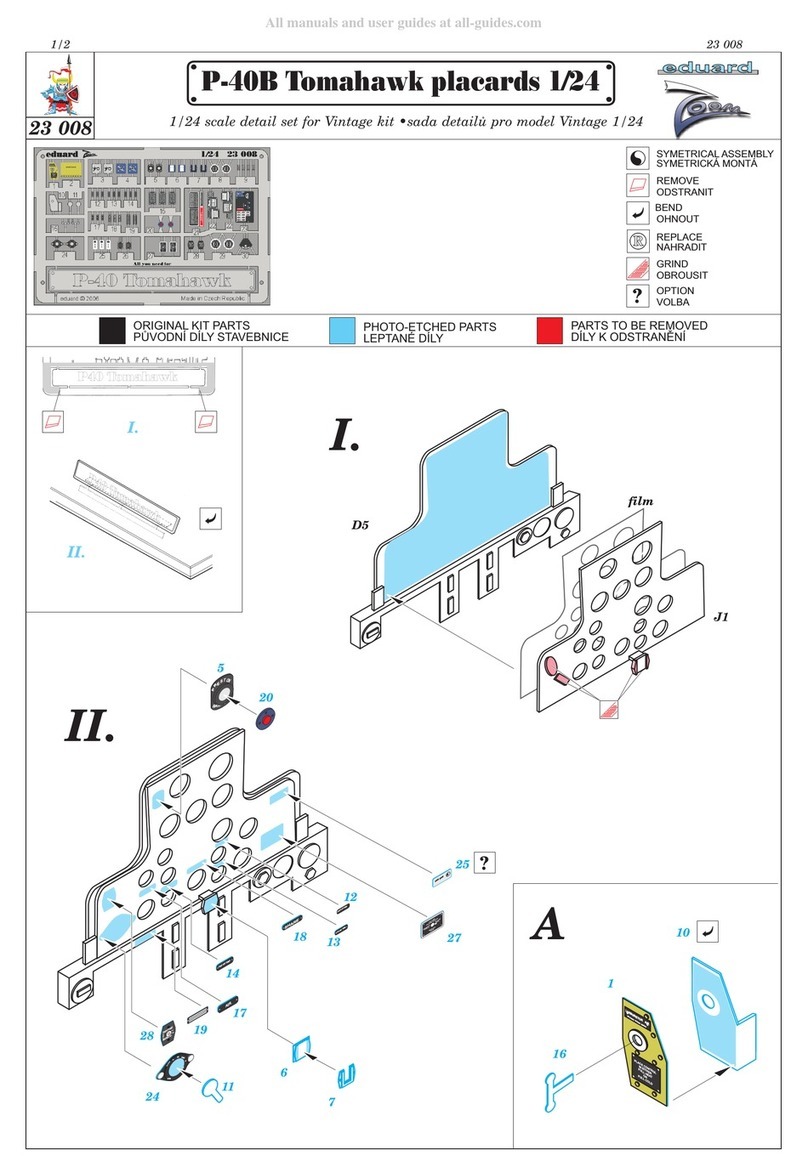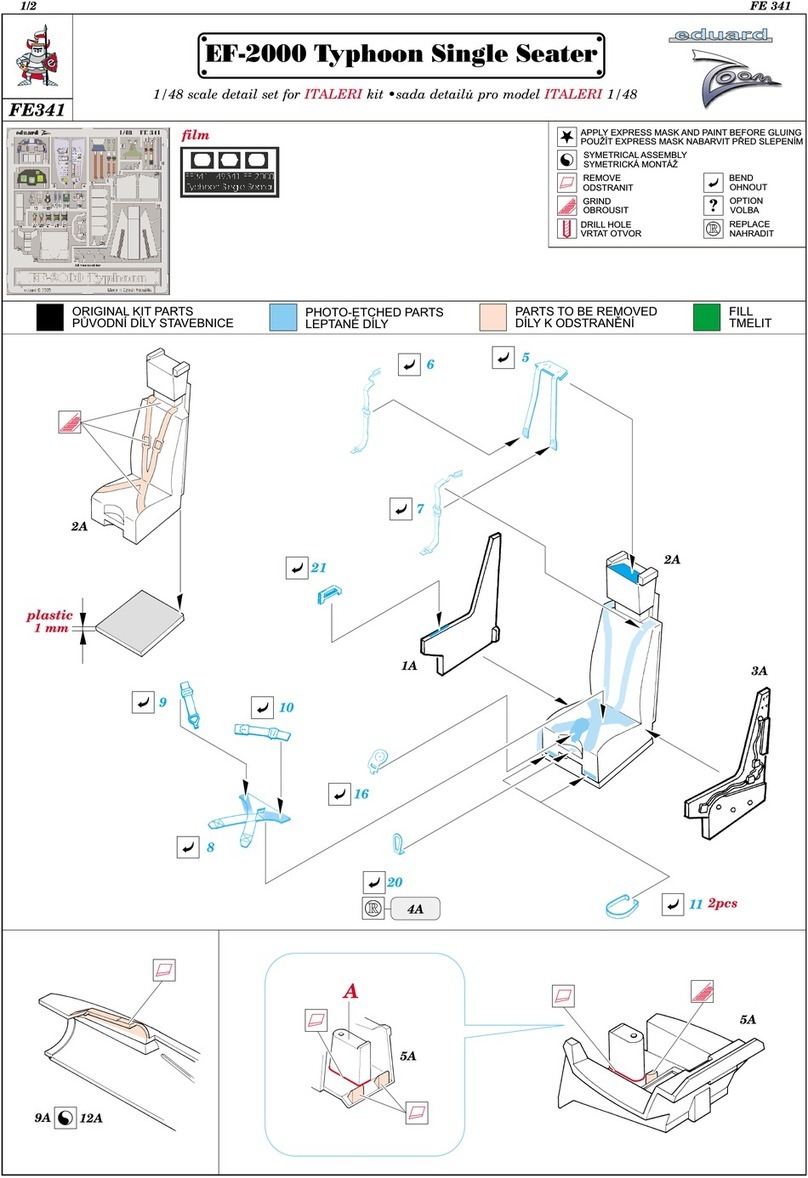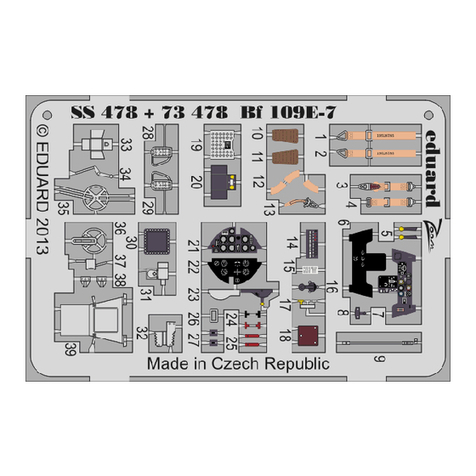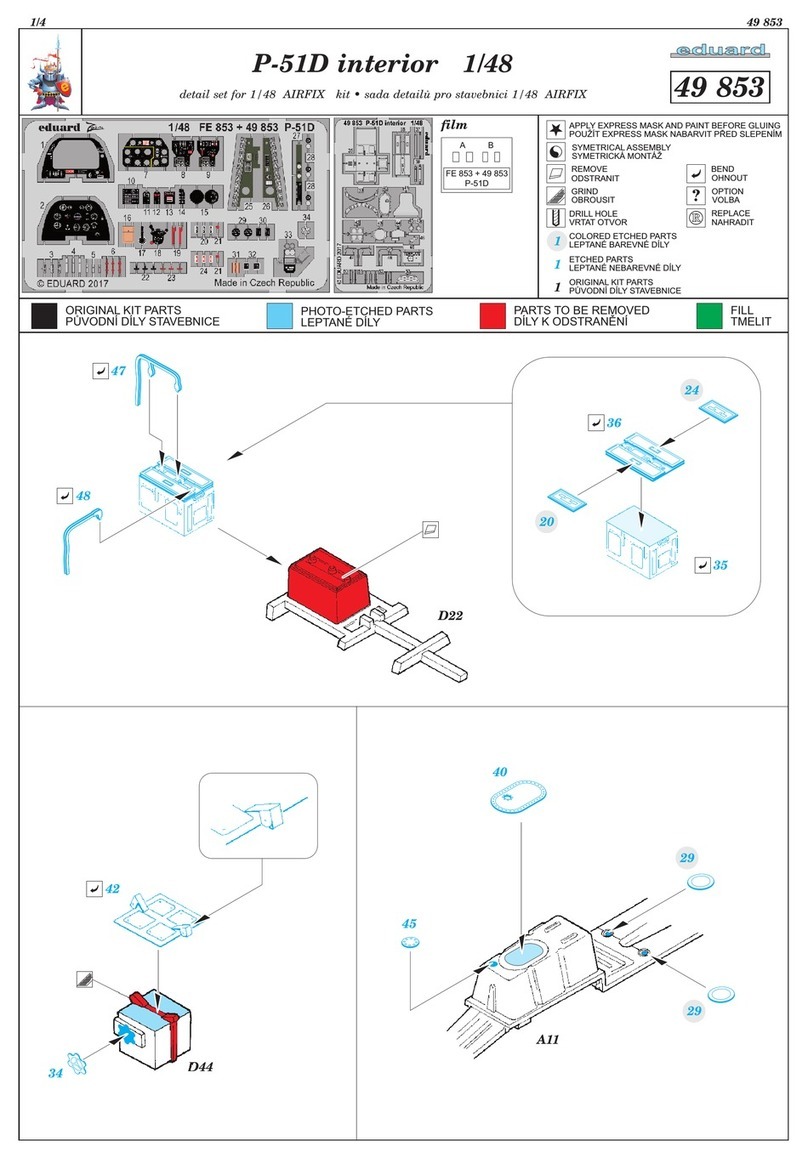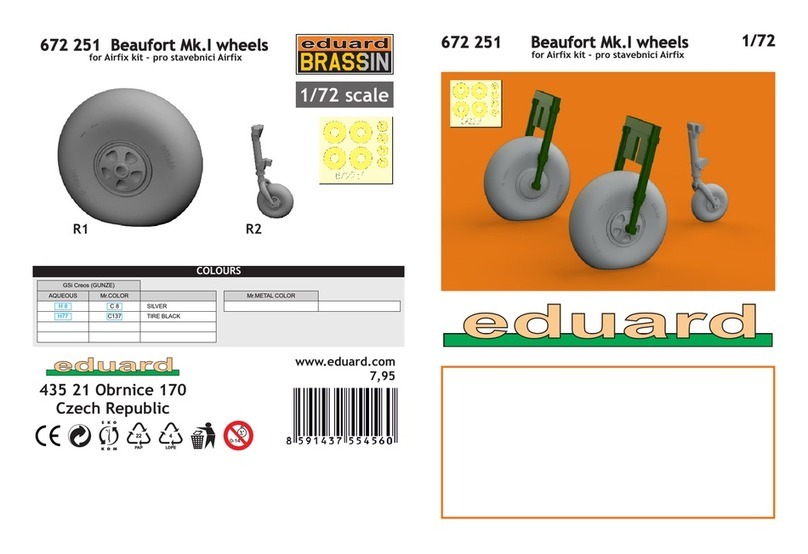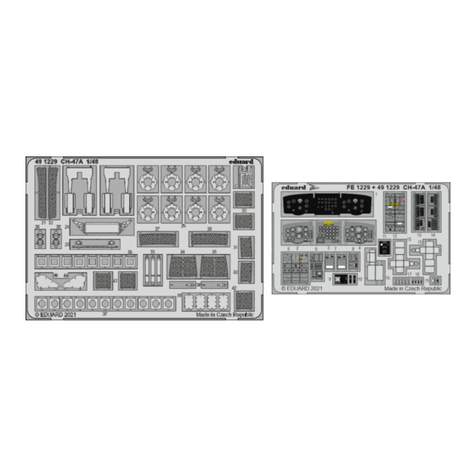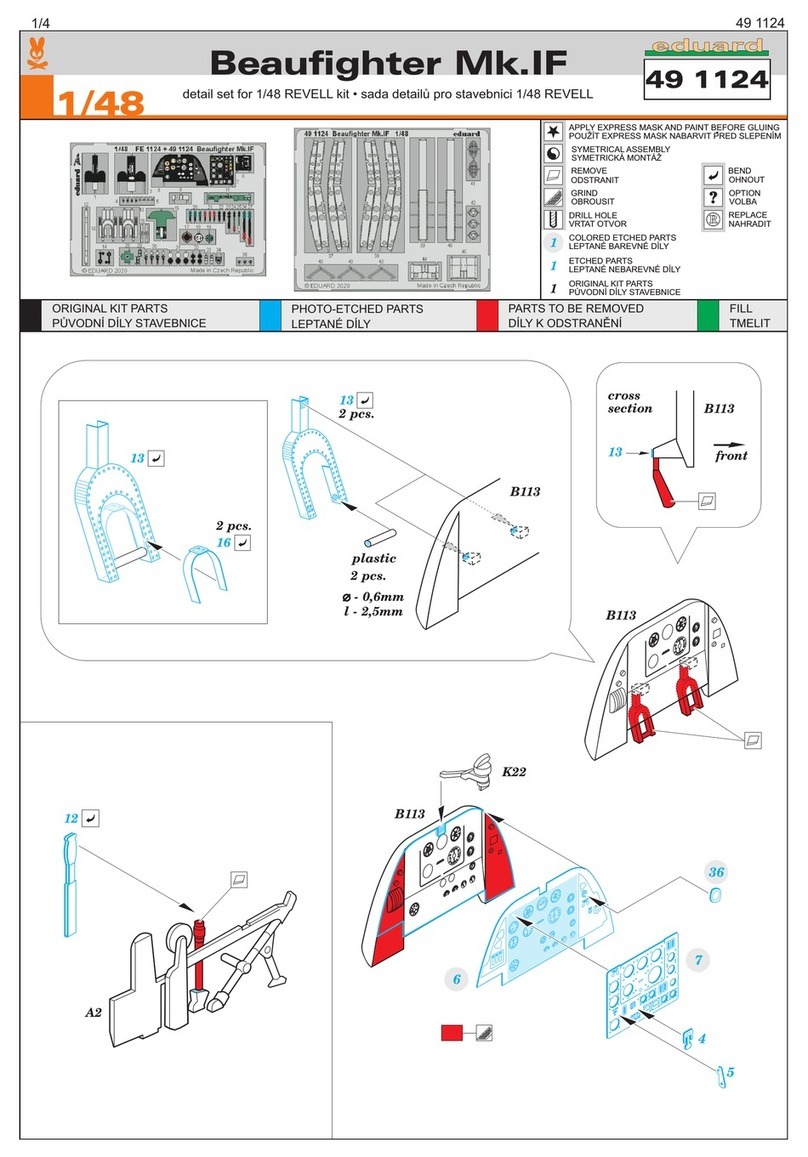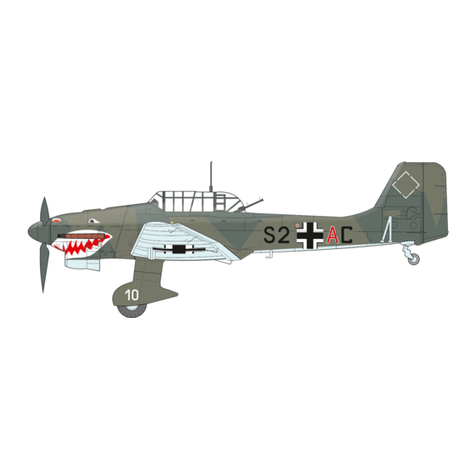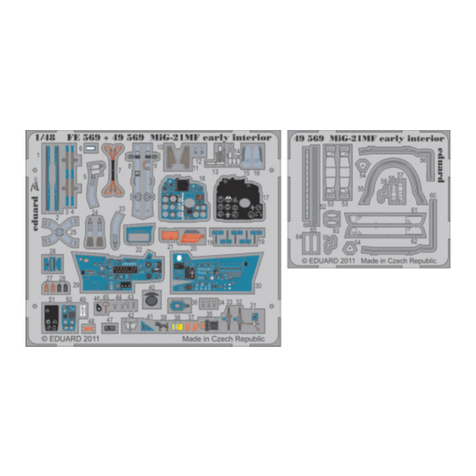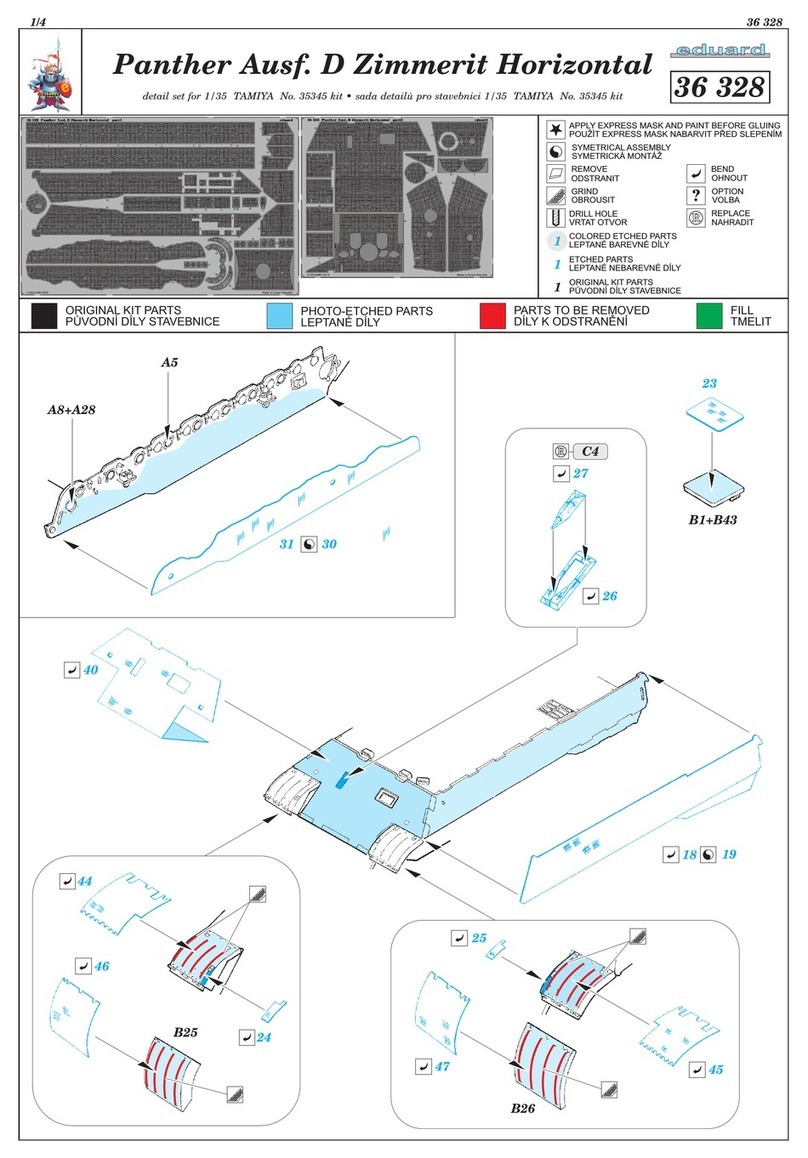
Mc213Mc214
Mc213
31
27
Mc214
C8 S13
32 204b 36 30
H13
3H11
62
H5
5
38
29 35
MiG-21MF/MFN
1:48 SCALE PLASTIC KIT
1158
eduard
intro
V této stavebnici, vydané v limitovaném poètu, najdete MiGy-21MA , MF a MFN, sloužící v èeskoslovenském letectvu, respektive v letectvu Èeské èi Slovenské
republiky. Celkem tøináct nabízených možností, jak letoun zbarvit, mapuje všechna období služby tìchto strojù. Mezi nimi se nachází také stroj 5303, který nosil
na ocasní ploše logo firmy Eduard. V celkem hektické dobì po pádu komunistického režimu v Èeskoslovensku mìli pøíslušníci ozbrojených sil možnost dávat
na svých strojích najevo náklonnost k rùzným oborùm lidské èinnosti. Kromì spoøe odìných dìvèat, více èi ménì dravých zubatých tlam tak na konkrétním letadle
dostalo prostor také plastikové modelaøení. Aè si mnozí myslí, že šlo o námi placenou reklamu, opak je pravdou a nás jen tìší, že modeláøi z øad vojenského letectva
fandí právì Eduardu. MiGy-21 verzí MA a MF se ve výzbroji èeskoslovenského letectva a jeho následovníkù, èeských a slovenských vzdušných sil, nacházely øadu
desetiletí. První kusy pøilétly ze Sovìtského svazu na pøelomu 60. a 70. let minulého století, poslední vyøazené kusy pøežily ve službì vìtšinu letounù, které
je pùvodnì mìly nahradit. Èeské jednadvacítky tak bylo možné na èeské obloze spatøit i poté, co modernìjší MiGy-23 skonèily na šrotištích èi v muzeích a MiGy-29
u polských sousedù. Definitivní náhradou sovìtských stíhaèek se staly až Gripeny. Slováci si svou èást MiGù-29 ponechali a jednadvacítky na Slovensku létaly
spoleènì s tìmito moderními stroji. Letouny MiG-21MA (tovární oznaèení Izdìlje 96A) byly dodány v poètu 24 kusù v letech 1969 až 1970. Jednalo se o náhradu
prùzkumných MiG-21R. Letouny pocházely z výrobních sérií 11, 12, 26 a 27. Bìhem služby prošla eMÁèka pøestavbou na standard verze MF, nicménì zùstalo
nìkolik odlišností, které jsou pro upravené stroje charakteristické. Jde zejména o tvar brzdících štítù, u nìkterých o absenci aerodynamických plùtkù u pøisávacích
otvorù, chybìjící periskop na pøekrytu kabiny atd. Na MiGy-21MA navázaly dodávky MiGù-21MF (tovární oznaèení Izdìlje 96F). Bìhem let 1971 až 1975 dostalo
èeskoslovenské letectvo celkem 102 kusù této verze. Pocházely z rùzných výrobních blokù dvou továren. Kamuflážní zbarvení také napovídá o jejich urèení a tedy
o drobných odlišnostech. Obecnì se dá øíci, že stroje dodané v barvì kovu èi svìtle šedé byly urèeny pro PVO, letouny kamuflované zelenými a hnìdými odstíny mìly
sloužit u frontového letectva. Tato skuteènost se projevila napøíklad ve vybavení kokpitu. Nejprve, v letech 1971 a 1972, pøišlo 24 strojù sérií 43, 44, 52 a 53,
vyrobených v moskevské továrnì è. 30 „Znamja truda“. Tyto letouny urèené pro PVO zùstaly bez kamufláže v barvì kovu. Bìhem dalších dvou let èeskoslovenské
letectvo dostalo 58 eMeFek ze sérií 76, 77, 78, 82, 94, 95, 97, 98 a 99. Opìt se jednalo o stroje z montážní linky moskevské továrny, tentokrát však byly urèeny pro
frontové letectvo a nesly zeleno-hnìdou kamufláž. V roce 1975 dorazila poslední dodávka MiGù-21MF. Tentokrát šlo o 20 letounù ze sérií 22, 24, 25, 30, 40, 41, 43,
44, 54, 55 a 56 z produkce továrny è. 21 v Gorkém (døíve a dnes Nižnyj Novgorod, pouze za bolševické diktatury Gorkij). Letouny byly již z výroby urèeny pro jednotky
PVO a nesly nátìr svìtle šedou na všech plochách. MiGy-21 se staly na dlouhá léta páteøí èeskoslovenského stíhacího letectva. Na konci 70. let je zaèaly nahrazovat
MiGy-23 a v dalším desetiletí také MiGy-29. Letecká technika se zcela pochopitelnì stala také jednou z položek, které si pøi rozpadu Èeskoslovenska rozdìlily
nástupnické státy. Èeské republice pøipadly ètyøi MA a dvaapadesát MF, Slovensko dostalo tøináct MA a šestatøicet MF. V letech 1999 a 2000 bylo deset vybraných
èeských strojù modernizováno na takovou úroveò, aby alespoò èásteènì vyhovovaly standardùm NATO, jehož souèástí se Èeská republika v roce 1999 stala.
Letouny prošly modernizací v Leteckých opravnách Kbely a nesly oznaèení MiG-21MFN (N jako NATO). Historie MiGù-21 na èeském nebi se uzavøela v roce 2005.
Slovenské ozbrojené síly vyøadily poslední jednadvacítky na konci roku 2002.
úvodem
N
This kit offers the option of building either the MiG-21MA, MF or MFN serving with the Czechoslovak Air Force, as well as with the forces of the separate Czech
and Slovak Republics. Atotal of thirteen options were chosen to represent all of the time periods in which this aircraft served. Among them is found aircraft numbered
5303, which carried the Eduard logo on its fin. In the hectic period after the fall of communism, members of the Czechoslovak armed forces found themselves able
to display symbols of affinity. Besides scantily clad ladies and, to a lesser extent, sharkmouth decorations, plastic modeling was also represented. Interestingly, this
was not a paid advertisement, and the marking was the result of having a fan base in the armed forces. The MiG-21 MAand MF served in the CzechoslovakAir Force
and with its successors for several decades. The first examples arrived from the Soviet Union at the end of the sixties and into the seventies. Most of the last
serviceable examples outlived their intended successors. Czech MiG-21s flew over the country after their more modern MiG-23 replacement ended up in scrapheaps
or museums, and the MiG-29 with the Polish Air Force. The final replacement in the Czech Republic finally came in the form of the Gripen, while the Slovaks
maintained their -29s, and these flew along side the MiG-21s. The MiG-21MA (factory designation Izdelye 96A) were delivered to the tune of 24 aircraft between
1969 and 1970. These were intended as replacements for the MiG-21R, and came from production series 11, 12, 26 and 27. During their service life, these MAs were
upgraded to MF standard, and there remained certain differences that are for modified aircraft characteristic. Generally, these centred around the shape of the air
brakes, the absence of aerodynamic fences at auxiliary intakes on some aircraft, a missing rear view mirror, and so on. The delivery of the MiG-21MA was followed
by the MF (factory designation Izdelye 96F). Between the years 1971 and 1975, the Czechoslovak Air Force accepted 102 units of the type. They came various
production blocks from two plants. Their camouflage colors tended to also give away their intended role, and there were minor differences. It can generally be said that
aircraft delivered in a natural metal or light grey scheme were intended for the air defence units, and aircraft camouflaged in green and brown were destined for frontal
units. The differences could be observed, for example, in the cockpit. At first, between 1971 and 1972, twenty-four aircraft arrived from production blocks 43, 44, 52
and 53, built at Moscow’s Factory No.30 ‘Znamya Truda’. These aircraft were intended for the air defence units, and as such, were delivered in natural metal. Over the
next two years, the Czechoslovak Air Force received another 58 MFs from blocks 76, 77, 78, 82, 94, 95, 97, 98 and 99. These too came from the Moscow factory, but
these aircraft were destined for frontal units, and carried a brown-green scheme. The last batch supplied came in 1975, and this was composed of twenty aircraft from
series 22, 24, 25, 30, 40, 41, 43, 44, 54, 55 and 56, produced at Gorkii (formerly and currently Nizniy Novgorod, only named Gorkii under bolshevik control). These
were also destined to equip the air defence units and came in light grey overall. The MiG-21 formed the backbone of the Czechoslovak fighter force for many years.
They began to be supplanted by the MiG-23 at the end of the seventies, and in the following decade, the MiG-29. Aerial assets understandably became a point
of discussion between the states that came out of Czechoslovakia. The Czech Republic was allocated four MAs and 52 MFs. Slovakia acquired thirteen MAs and
36 MFs In 1999 and 2000, ten Czech aircraft were selected to be modernized to at least partially satisfy NATO standards, of which the Czech Republic became
a member in 1999. The aircraft passed through the upgrade at Aircraft Repair Works Kbely, and were given the designation MiG-21MFN (‘N’ for NATO). The history
of MiG-21 in Czech service drew to a close in 2005. Slovakia retired their last MiG-21 at the end of 2002.
Czechoslovak / Czech aviation units, List of abbreviations:
slp – Fighter Regiment, pzlp – Recconnaissance Regiment, sbolp – Fighter-Bomber Regiment, lsp – Training Regiment, sslt –Independent Fighter Squadron,
tl – Tactical Squadron, slt – Fighter Squadron
in the Czechoslovak service





